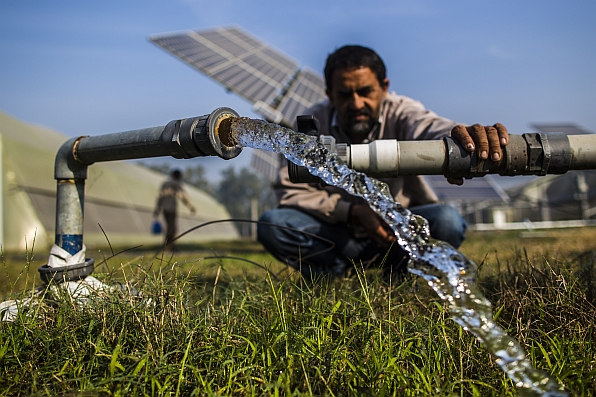Yes – with a few ifs, ands and buts

Photo: Prashanth Vishwanathan / IWMI
What’s not to like about the idea of using solar-powered pumps to irrigate crops in developing countries? Governments see it as a way to lower carbon emissions in fulfillment of the Paris Climate Agreement. Civil society organizations appreciate its potential to improve water access for multiple uses, including more intensive and resilient crop production as well as health and hygiene. Private companies are eager for opportunities to expand the market for solar-powered pumps. Smallholder farmers have mixed views. While many consider solar technology to be expensive and technically complex, they tend to change their tune, once they get a chance to try it out for themselves.
Such appears to be the case in India, where the International Water Management Institute (IWMI) is developing and testing various approaches to solar-powered irrigation through the CGIAR Research Programs on Water, Land and Ecosystem (WLE) and Climate Change, Agriculture and Food Security (CCAFS), with support from the Tata Trusts. In a pilot effort at Chakhaji village, Bihar State, six young solar pump service providers quickly displaced the 18 diesel pump owners who had previously catered to about 400 smallholders by irrigating their plots much faster and cheaper. A recent preliminary IWMI study in Ethiopia found that women prefer solar power, especially when the pump is located close to home and the water can be used for multiple purposes.
With so much interest in solar-powered irrigation, it comes as no surprise that this is one of the options featured in a new CCAFS working paper titled Ten best-bet innovations for adaptation in agriculture. Prepared in the run-up to COP 23 – the 23rd Convention to the Parties of the UN Framework Convention on Climate Change (UNFCCC) – the document is intended to serve as a supplement to the UNFCCC technical guidelines for national adaptation plans.
For countries opting to promote solar-powered irrigation, the challenge is “tailoring this technology to specific circumstances,” so as to “expand irrigation access to the largest number of poor, while keeping its costs affordable . . . and minimizing its environmental footprint,” explains Tushaar Shah, the IWMI scientist guiding this work in India and lead author of the section on solar-powered irrigation in the CCAFS working paper.
To find ways of using this technology sustainably, Shah and the IWMI/WLE team experimenting with it in Asia and Africa pursue a business model approach. This means they focus not on the technology per se but on the institutional, financial and environmental conditions that are necessary for it to have the desired effect. Based on recent experience, the team has a lot advice to offer, which can be summarized as follows.
- Put it on the map – Plans to boost investment in solar irrigation should be guided by suitability maps showing where the technology is appropriate and where not. Such an exercise in Ethiopia suggested that solar irrigation is potentially suitable on up to 7.2 million hectares. The pilot in Bihar could be spread to about 20 million.
- Do your homework – Whether it proves feasible to realize this potential depends a lot on each country’s regulatory framework, which may pose opportunities as well as obstacles. In India, for example, capital subsidies on small solar pumps for individual farmers are a key barrier to the spread of the robust model being piloted in Bihar, which relies on larger pumps to provide cost-effective irrigation services. The subsidy, by removing any incentive to lower the costs of larger pumps, restricts market expansion.
- Follow the money – The need to expand irrigation among smallholder farmers dependent on rainfed agriculture is clear. Not so clear is how to finance the spread of solar pumps for this purpose. The pilot project in Bihar offered service providers a 60% capital cost subsidy; they are covering the other 40% through an upfront payment, followed by four annual installments. More accessible financing is needed to facilitate investment. In Ethiopia, researchers propose several options that link farmers to finance through, for example, outgrower schemes or contract farming.
- Look out below – One of the environmental concerns surrounding solar-powered irrigation is that it could lead to overuse of groundwater. In Bihar, studies suggest that aquifers can support more intensive cropping with little threat of long-term groundwater depletion. Similarly, if solar-powered irrigation is adopted widely in Ethiopia, the withdrawals of freshwater are expected to be minor, compared with the country’s annual renewable supply. Even so, since water is a contested resource in this and other countries, innovative governance is needed to resolve conflicts, accompanied by effective monitoring to warn of any negative impacts on ecological services, alongside social and economic gains.
A central social concern is who reaps these benefits in rural households. Although preliminary evidence suggests that solar-powered irrigation shows much promise for women, especially when the technology is associated with multiple water uses, the jury is still out on this issue.

